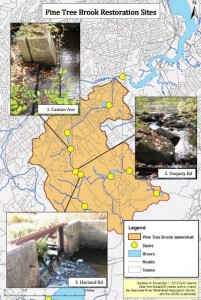NepRWA launches ambitious dam removal program
By Jay TurnerAfter a promising start followed by some unexpected delays, the Neponset River Watershed Association is moving full steam ahead with its small dams program — an ambitious, long-term, and ultimately costly project targeting the roughly 100 obsolete dams along the Neponset and its tributaries.
Over the next several years, the watershed association, which is headquartered on Route 138 in Canton, will aim to modify or remove as many of these outdated structures as possible, thereby improving water quality, wildlife habitat, and fish passage in various locales along the watershed from Foxboro to Boston.
“What these dams really do is they chop the river up, leading to habitat fragmentation and preventing the fish from moving up and down the stream,” explained NepRWA Executive Director Ian Cooke. “It’s not the only problem facing the health of our streams, but it certainly is an important one.”
Initially launched last spring following a successful fundraising campaign and completion of a challenge grant, the small dams program had to be put on hold just a few months later after both of its proposed pilot sites — one in Canton and one in Westwood — encountered resistance from abutters.
In the case of the Canton dam, which is located just upstream of Elm Street on Ponkapoag Brook, Cooke said the property owners on one side of the stream were very supportive of the proposed removal while the landowners on the other side balked at the idea.
“They were not interested in having us go forward and study the possibility,” Cooke said.
Preferring to target sites that have enthusiastic support, Cooke said NepRWA officials decided to revisit the comprehensive dam survey that the watershed association completed several years ago, and now they seem to be “back on track with several new possibilities in the pipeline.”
Among the new targets are three small dams along Pine Tree Brook in Milton, located north of the Blue Hills Reservation near the Ulin Memorial Rink. All three dams lie on land owned by the state Department of Conservation and Recreation (DCR) or the town of Milton.
 Cooke said two of the dams are small structures with “no modern purpose and no aesthetic or other public use.” The third is a flood control dam — one of only two in the watershed; however, NepRWA believes that a “minor modification” could restore fish passage without impacting flood control operations.
Cooke said two of the dams are small structures with “no modern purpose and no aesthetic or other public use.” The third is a flood control dam — one of only two in the watershed; however, NepRWA believes that a “minor modification” could restore fish passage without impacting flood control operations.
According to Cooke, “The upper reaches of Pine Tree Brook are believed to support a wild trout population, and restoration at these three sites could potentially be a benefit to this iconic and relatively rare species.”
NepRWA officials have already conducted site visits with staff from the DCR and the Milton DPW, and they recently decided to submit all three sites to the Division of Ecological Restoration for consideration as “priority projects,” which would pave the way for technical assistance and potentially more funding in the future.
Besides the three dams in Milton, Cooke said NepRWA is also working on a short list of “micro-dams” that could “easily be disassembled by a small group of volunteers in an afternoon.” He said that most of them are “little more than a few rocks piled in a stream,” yet they still have a significant ecological impact — and still require various approvals and permits before they can be removed.
“One of the activities that requires more permits than anything is removing a dam,” explained Cooke, while noting that in some cases, the cost of permitting exceeds the cost of removal by tens of thousands of dollars.
Beyond the time and money that it takes to remove a dam, Cooke said there are also many misconceptions about dams that they have to contend with, including the notion that dams prevent flooding.
“The dams we’re talking about are always full; they’re not holding any water back,” he said. “A lot of these dams are actually causing flooding.”
He added that most of the dams they are targeting for removal go back to the days of water power and no longer serve their intended purpose.
“Removing dams is something that’s very counterintuitive for a lot of folks,” he acknowledged. “A lot of these structures have been around longer than people in Canton have been alive, and they tend to think of them as a natural part of the landscape.”
Despite these and other obstacles, Cooke said NepRWA remains excited about the small dams program and the prospect of a free-flowing Neponset River.
Cooke thanked Margaret Kearns of Instar Ecology for helping to lead the effort over the past few months and Carly Rocklen, former restoration manager, for launching the program and for spearheading a fundraising effort that netted approximately $30,000 in seed money.
Rocklen was also instrumental in articulating a vision for the program and for touting the many benefits of dam removal on the NepRWA blog.
As she wrote last August, “When dams come down, towns experience physical and aesthetic changes to the landscape and also gain new and improved recreation options. A familiar waterway will revert to a more natural, historic shape and flow, which only people from the past may have known. Residents and river users become accustomed to seeing different fish, wildlife and plant communities … The structure of the dam is no longer part of the landscape, and neither is the mill pond that was associated with it. Recreation options widen and improve — people can paddle further up and down rivers, and fishing opportunities diversify.”
To learn more about the Neponset River Watershed Association’s small dams project, visit the NepRWA blog at www.neponset.org or email Ian Cooke at cooke@neponset.org.
Short URL: https://www.thecantoncitizen.com/?p=24960










